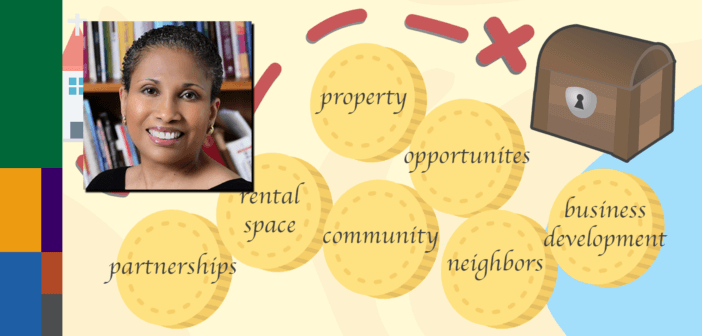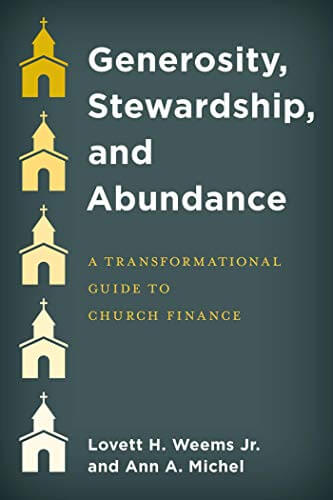Your church may have more resources than you think. In an interview with Ann Michel of the Lewis Center staff, Jacqueline Jones-Smith explains how Christ Church in St. Petersburg, Florida, once slated for closure, turned itself around by embracing a more entrepreneurial mindset and taking stock of its physical and human assets.
Listen to this interview or continue reading.
Ann Michel: Can you briefly describe the situation Christ UMC faced when you first arrived as pastor?
Jacqueline Jones-Smith: Christ Church St. Pete was then a 127-year-old church, well known for a day care it had started in downtown St. Petersburg, well known for its music ministry and its mission outreach. Many elders and a couple of bishops had come out of the church, and over the years it had launched a number of new churches in the suburbs. Unfortunately, as in most mainline churches, it suffered a marked decline in membership starting in the 1970s. The church had once in worship over 1,000 people a week. It has a 1,200-seat sanctuary. But, by 2009, the church had less than 100 worshippers. In 2002, it started to draw down on the excess of its endowment of about $2 million. In 2009, it began to withdraw from the principal corpus of its endowment. When I arrived, there was about $500,000 left in the endowment. By 2013, it cut back from a full-time pastor to part-time pastors. And by the time I arrived, there had been maybe five different part-time pastors in two and a half years. In fact, the first question many people asked me was “How long are you going to be here?” And, from what I understand, Christ Church was on a list of churches that potentially needed to be closed.
Ann Michel: Why did you decide to take on this challenge?
Jacqueline Jones-Smith: When my husband and I attended services there, a retired former pastor looked at me and said, “We’ve been praying for you.” And we prayed about it. And my husband said, “I think God’s calling you back into the parish.” So, it was purely God’s call.
Ann Michel: Could you say a bit about what happened after you assumed the pastorate of the church?
Jacqueline Jones-Smith: All of our backgrounds come to bear when we go into pastoral ministry. My background is in business and the law. I immediately realized the church needed to look seriously at its finances. As a condition of me coming to the church, I asked the conference to do an external audit of the finances. I looked very seriously at that. And immediately, within about the first 60 days, we were able to cut down some of that endowment draw just by cutting spending.
I believe when you first go into a church you have the opportunity to do some important branding and to bring people on board with a theme. And so, I preached my first sermon from Isaiah 43, that God is about to do a new thing. I used a rubber band as imagery. And I said “We need to let God stretch us. As stakeholders in this community, we have to stretch. It’s going to cause tension. We’re going to have to do some things we’re not used to. But let’s do that.”
Within a few months, I realized that the church really needed to leverage its assets to get some money in or else it wasn’t going to make it. I just took a serious look around and asked, “What did we have?” First, we identified the tangible assets, including the property and building. The church is located in the middle of downtown St. Pete right next door to City Hall. The church also had a building with 50,000 square feet of amazing space including a sanctuary that holds 1,200 people. And the church owned a 2/3-acre lot across the street that provided a small amount of parking. Next, we looked at our endowment, restricted and unrestricted funds. Then, we looked at the intangible assets. Who were the people in the church with untapped skills and abilities? Who were potential partners? What relationships did we need? We also looked around at the economic environment of the city. It was clear that development was happening downtown. And the parking lot that the church purchased maybe in the 1950s was potentially worth a lot of money.
I realized some of this work was beyond what our church trustees could handle. So, I formed a business development task force to build close working relationships with the St. Petersburg government, the Chamber of Commerce, and other businesses and community groups, and to explore and investigate business opportunities that could generate revenue for our church. This business development group included people in the congregation that had untapped skills and abilities. For example, one of the retired pastors had one of the largest CPA firms in the city. He just got a call to ministry late in life. One church member was a former county commissioner and vice mayor of the city of St. Petersburg. But the church had never tapped his ability. This task force included a retired banker who dealt in commercial banking, a former county commissioner, and the head of a CPA firm. And my husband headed this business development task force, which was unusual. In the past, he had always been a silent partner. My husband had never held any position in the church. But I made him chair of this group because he’s a nationally renowned entrepreneur and business executive who had been on several corporate boards, for example, FedEx and Caterpillar. The group was advisory, not decision making. They reported to me and made recommendations to the Trustees.
Ann Michel: So, what did your business development task force learn?
Jacqueline Jones-Smith: First, they learned that the church’s parking lot was in a highly desirable, high-density development area. Second, they learned there was a shortage of rentable space in downtown St. Pete and a high level of interest among nonprofits in renting space in Christ Church. So, the business Development task force saw two areas of revenue. One was renting our building. And the second was selling the lot. The plan was to sell the lot first because we needed revenue to work on the building so that we can eventually rent out the space. We found a commercial real estate firm to work with us. And we made recommendations to the trustees. Of course, they accepted it.
On December 13, 2019, we sold the 2/3-acre lot for $5.3 million. That’s how valuable it is. But the unique thing is this deal required easements for parking spaces — the church has about 100 parking spaces in the new structure in perpetuity. Because as a downtown church we’ve got to have parking. When you count the easements, the deal is valued at about $6.3 million. It’s considered one of the highest per-acre sales in downtown St. Pete. And some other churches have actually copied that business model.
Ann Michel: If the church had an asset worth so much money and had the talent within its congregation to think about how it could be leveraged, why didn’t they think of it before?
Jacqueline Jones-Smith: That’s an interesting question. First, I’ve found in my experience that churches generally don’t like to sell property. In fact, at Christ Church, many people at first were very concerned about the idea of selling the property because the church bought it so many years ago. And let me tell you, this was a weeded-out lot. There were some parking spaces, but a section of the lot was totally overgrown with weeds. Some people wanted to start an urban garden, which in and of itself would have been fine. But the church desperately needed an infusion of cash. I didn’t call it “selling” but “leveraging assets.” Because we still ended up with more parking.
Second, I think a lot of churches don’t look at the skills and abilities that people exercise in their secular life. But churches often only focus on what I call the “church jobs.” And so, they were surprised to discover their untapped human capital.
Ann Michel: What were some obstacles you faced?
Jacqueline Jones-Smith: First, we needed to create the capacity to act quickly. If our Trustees had handled this on their own, it would have taken a while. Like most church committees, they meet on a monthly basis. They take minutes. In contrast, the business development task force would meet when necessary. They communicated constantly. They didn’t worry about minutes and Robert’s Rules. They were able to get to the heart of the matter. Second, we had to reestablish a good relationship with the Conference. The church had been in a preservation mode and there was a lot of paranoia and concern that the Conference was going to close them. It took a lot of convincing to persuade people that we weren’t trying to harm the church, but we really needed to get some money. We also had to bring our Conference leaders along. A new district superintendent came in when I came in. So, we had an opportunity to educate her. She’s a great thinker who’s good at out-of-the-box thinking. And so, she liked the ideas. But we had to present our plan to the Conference in a way they could understand. “This is where we are going. No, Christ Church isn’t trying to pull a fast one.” So, we were gathering support from within the conference and within the community for this.
Also, we had to educate the congregation about their financial realities. Many people believe the church is going to be there forever. They give their offerings and the church just kind of sits there and runs. We did a series of educational events with the membership and the leadership to explain our financial condition, the fact that weekly offerings do not fund the budget and we are drawing down an endowment. And we used a lot of simple examples. For example, “If you earn a certain amount every week and you spend more than that, you’re going to have to go into your savings account.” Finally, I had to establish my own credibility. The church had seen so many pastors come and go before I got there. And while I accepted a part-time appointment, I didn’t come in as a part-time pastor. A turnaround requires a serious commitment, and it takes a lot of time. With some time, the members started to see that I was very serious about wanting the church to survive.
Ann Michel: Once the church realized they’d have some money in the bank, how did you keep them from just going back to everything they’d done before?
Jacqueline Jones-Smith: When I created the goal of needing to leverage assets, it became part of an overall Christ Church Vision 2020. One of the things we’re looking at is expanding some of our current outreach ministries. The church has a unique laundry ministry. We go to laundromats in some of the more economically challenged areas and just pay for people’s laundry. If you don’t have a washing machine and have to pay to do laundry, it’s a big deal. You might have to choose between paying for your laundry and buying diapers or formula. One of Vision 2020’s goals was to expand the laundry ministry further throughout the city. We also want to bring back an after-school program focused on the arts. Some of the funds will be used to upgrade our current facility so that we can rent it. Christ Church’s 1,200-seat sanctuary is bigger than many of the performance venues in St. Petersburg. And so, part of our goal is to be able to provide a less expensive performance venue for nonprofits and schools. We are a small church in a big building, so we are looking at renting space out to nonprofits. But unfortunately, much of that now has been put on hold because of COVID.
Ann Michel: Did you get pushback from your church when you used the word “business?”
Jacqueline Jones-Smith: I did at first because many of the folks don’t believe that the church is a business. But one of the things I believe and I tell people is that “The church is a business. We’re in the business of making disciples for Jesus Christ. But we are a business.” Under state laws, we are a 501(c) 3 nonprofit corporation. And you know yourself, Ann, from your research and experience, if churches don’t pay payroll taxes, the IRS is going to get you. So, the government treats you as a corporation. Also, we don’t want to admit this, but the church is evaluated and measured by decision-making structures that use business metrics, for example, the number of members that you have, the number of people that you worship, are you paying your apportionments? In fact, those are some of the reasons that conferences decide to close churches. So, let’s be real. The church is not immune from the laws of economics. Nor is it immune from accountability to higher corporate structures. Within our United Methodist Church, churches are evaluated by metrics. And they are numbers. Period. Although it took a lot of explaining and talking about it, I think our congregation understands that a little more than most because they were concerned about being closed.
Ann Michel: Not every congregation is situated in such a prime location where their land is so very valuable. But still, there are ways every congregation can start to take stock of its resources. So how would you recommend that a church begin the process?
Jacqueline Jones-Smith: I think you have to have some objective people look at your physical assets and what you own. You own your building. You may own some vehicles. Look at your real property. You also need to look at your intangible assets. Don’t just look at your gift surveys. Get to know your congregation. Does the congregation have attorneys, teachers, or political figures? Another part of your asset base from a business standpoint is your good will. How are you perceived in the community? What do people in the community know about you? What is the church’s reputation? At Christ Church, even though the church’s membership had diminished, its child development center has an incredible reputation. Many people who worked downtown, including people at City Hall, had their children in the child development center. And yet there were no relationships. So, who are your neighbors? Who are the people in the community? What’s your reputation? And then you can try to build on that. These relationships also are assets you can leverage. Are there organizations in the community you can team with, nonprofits such as the Boys and Girls Club? One of our goals is restarting our after-school arts program. One of the things we want to look at is teaming with, say, the Boys and Girls Clubs or the YMCA, because they have an after-school program every day of the week, five days a week. You have to look for new partners because they can bring extra hands, extra people, possibly extra resources. So, when I say leveraging assets, it’s not just about the four corners of the building around you or what you own. It’s also the people in your church, the people in the community, the organizations you can you team with, and other churches.
Related Resources
- 7 Dos and Don’ts When Considering the Redevelopment of Church Property by Rick Reinhard
- Reimagining Church Buildings by Dave Harder
- When Churches Engage the World of Business by Audrey Warren







